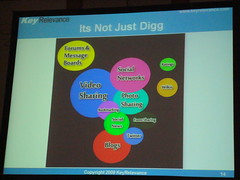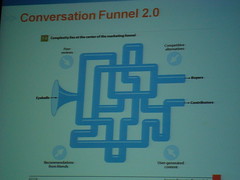Thinking about social media? Or are you waist deep and need some help? A session today at SES NY highlights different approaches to social media, its purpose and how and why you should get involved.
Li Evans, of Key Relevance, hammers home the need for social media strategy within her presentation.
Social Media – done for the sole purpose of traffic or links – probably isn’t social media you should be doing. Social media is not about your marketing message, it’s about what the customer has to say good or bad. It’s about them talking about you.
Whatever you do socially, remember that the end user has control of your message and sometimes your brand. Li goes on to explain that these conversations are happening any way, online and offline, so would you rather be part of it or continue to ignore it?
Imagine if a group of your customers invited you to a party they were having to talk about your product? Would you attend? Of course you would. Or you would be stupid not to.
So when those ‘parties’ are happening online every day it’s interesting how many companies don’t rsvp.
Li reminds the audience, that there are multiple tools to help you engage in Social Media. It’s not just Digg or Facebook or Twitter. 
But before thinking about the tools, think about your overall approach.
1. Start with a plan
2. Know where your audience is online
3. Integrate with SEO and PPC
4. Define Goals & Measure, Measure, Measure
5. Take What Works & Improve it
Next, is Beth Harte, of Harte Marketing & Communications.
She starts by explaining that attention to social media by the PR industry is lacking. Specifically, the industry tends to still focus only on media, dodging crisis and ignoring customers.
It’s no longer just about the journalist. There are many conversations on blogs, forums, social media and PR needs to move toward putting the customer first.
Once you have a plan that rolls up to objectives and strategy, here are a couple ways to dive in:
1. Online newsroom, make it more than a repository for press releases
2. Social Media News Release which is searchable, includes keywords and tells a story
The next step for the PR Person is to connect the dots between offline and online to reach customers in a more effective way.
Rob Key, of Converseon, is here to represent the agency side of Social Media.
The marketing funnel has gone from a very linear approach to a Dr. Seuss type of funnel  which includes conversations in multiple destinations and specifically destinations that aren’t always controlled by the brand.
which includes conversations in multiple destinations and specifically destinations that aren’t always controlled by the brand.
While social media may not be hard to execute, culturally it can be very difficult. Since social media transcends marketing disciplines, it makes it even more difficult.
When developing social media:
- Utilize and engage different groups (comm, marketing, media, search)
- Pilot with low-profile business unit
- Encourage your clients to start listening first, then engage
Social media can be successful when you:
1. Listen
Free tools like Google Alerts can get you started. Conversation monitoring is documenting conversations. Conversation mining is taking the information, creating insights based on sentiment and letting that information drive what you do next.
2. Organize
Social media is an engine of organization transformation. Within client organizations, help them decide who ‘owns’ social media to make sure you have an internal champion and educator.
3. Policy/Ethics
Understand the cultural nuances of the different communities and educate the client on what is appropriate in what channel.
Work with your client to create a code of ethics and guidelines in an effort to increase confidence and cut down on the review process.
4. Infrastructure
Identify what conversation assets you have and what ones you need. How will you make this happen and within what timeframe?
5. Identify opportunities to listen and connect
Every social network is not right for every brand. Select based on where your target market is.
6. Engage with the Right Philosophy
Participate and learn. Identify the elders and come bearing something of value.
7. Measurement
Measure changes in conversation, increase in positive sentiment, share of conversation.
Then identify what a 10% increase in sentiment means to the overall business.
There are many ways to dive into social media, doing so with a plan is the first step to being successful and providing something of value.


